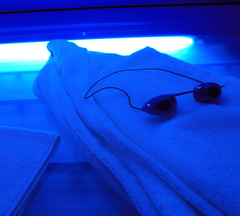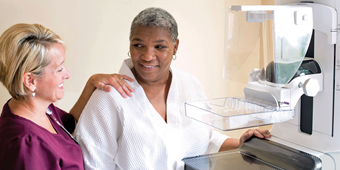Understanding Melanoma

Answer a few questions and we'll provide you with a list of primary care providers that best fit your needs.
Not all skin cancers are created equal. Protect yourself by learning more about melanoma, a serious form of the disease.
Melanoma is a skin cancer that begins in the melanocytes, one of the three types of cells in the top layer of your skin. The other two layers – squamous cells and basal cells – have their own types of cancer. Melanoma is much less common than basal cell and squamous cell skin cancers.
Melanoma can be life-threatening. It has the potential to spread to other organs and even cause death.
Any place on the skin can develop melanomas, but arms and legs are where women are more likely to develop them. The good news is that melanoma can often be found early, when it’s most likely to be cured.
Detection
Some health care professionals do a skin examination as part of a routine exam. Great idea!
But many times, women themselves are the ones who notice such symptoms as:
- Any change in a mole
- Redness or a new swelling beyond the border of the mole
- A sore that doesn’t heal
- Change in sensation, such as itchiness, tenderness, or pain
See your health care provider if any of these occur on your body.
Diagnosis
If the dermatologist finds a mole or other spot that looks like melanoma, she or he will remove it (or part of it) and send it to a lab. This is called a biopsy, and melanoma cannot be diagnosed without it. Other tests that a patient may need include X-rays, blood work, and a CT scan.
The good news is that melanoma can often be found early, when it’s most likely to be cured.
Treatment

The type of treatment given depends on the patient’s health and how deeply the melanoma has grown or spread.
Often a surgical procedure is used for melanoma because doctors want to remove all of the cancer. In Mohs surgery, the surgeon removes cancer layer by layer, until no cancer cells are found. Mohs surgery has a high cure rate.
If the melanoma has spread, a patient may need more treatment, including removing lymph nodes, chemotherapy, radiation, or immunotherapy.
Prevention
Age, complexion color, family history and other risk factors increase the chances of melanoma.
You can lessen your risk by:
- Staying in the shade or if in the sun, cover up your skin with clothing, including a wide-brim hat and UV-blocking sunglasses
- Avoiding sunburns, by using a broad spectrum (UVA/UVB) sunscreen with an SPF of 30 or higher
- Avoiding tanning beds
- Examining your skin every month
- Having a yearly skin check by a health care provider
Answer a few questions and we'll provide you with a list of primary care providers that best fit your needs.
Source: American Cancer Society; American Academy of Dermatology




